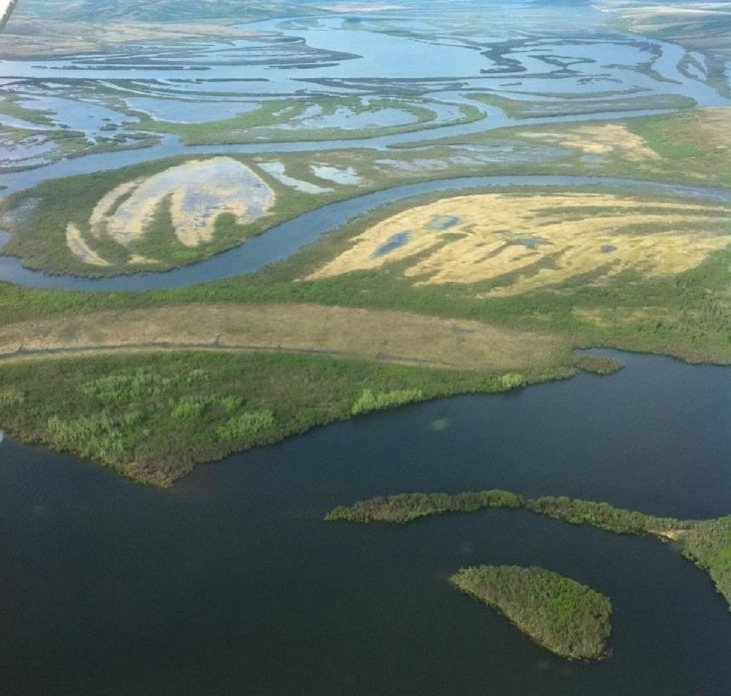Lower Yukon River wildfire is among Alaska’s largest tundra fires on record
Tundra fires can speed up harmful climate feedback cycles.

A wildfire that has scorched 153,505 acres near the Bering Sea mouth of the Yukon River is now Alaska’s largest tundra fire in 15 years and one of the largest in decades, according to a University of Alaska Fairbanks scientist.
The East Fork fire burning in the Yukon Delta National Wildlife Refuge and near the Yup’ik village of St. Mary’s, has grown dramatically since it was sparked by lightning on May 31.
It is the biggest tundra fire on record in that area of the lower Yukon River, and it is also part of a trend of increasingly frequent tundra fires in that region, said Rick Thoman of the Alaska Center for Climate Assessment and Policy at UAF.
“Just like the elders in St. Mary’s have been saying, there’s way more vegetation on the tundra than there used to be. There’s more fuel available,” Thoman said. That, he said, is because of the warming climate.
As of Monday, there were 240 people working on the East Fork fire and trying to ensure that it does not affect the village of about 600, said Nina Chambers, an information officer working for the incident management team. No structures have been lost, but about 90 residents — mostly elders, children and others with respiratory vulnerabilities — were staying in the hub community of Bethel, having voluntarily evacuated, Chambers said.
Gov. Mike Dunleavy on Friday approved a disaster declaration to help the emergency response in St. Mary’s and the nearby village of Pitka’s Point, home to about 125 people.
Another lightning-sparked fire, the Apoon Pass Fire, is burning on tundra in the same general area. But because of its smaller size — 29,922 acres as of Monday — and its distance from communities, it is being merely monitored while firefighters focus on East Fork, Chambers said.
One of the most significant Alaska tundra fires was the “unprecedented” 2007 Anaktuvuk River fire on the North Slope, which burned for months and covered about 256,000 acres in a treeless and moist region where fires are unusual.
Tundra fires add to a cycle that exacerbates climate change effects, scientists have found.
If they burn sufficiently deep, they thaw permafrost and release sequestered carbon. The Anaktuvuk River fire of 2007, scientists found, spewed a volume of carbon into the air equivalent to the average amount of carbon absorbed annually in the 20th century by all the world’s Arctic tundra habitats, according to a 2011 study published in the journal Nature.
Tundra fires also hasten the spread of woody shrubs into terrain that would otherwise be dominated by tundra plants like mosses and lichens, both in northern Alaska and, though in a more uneven pattern, in the Yukon-Kuskokwim Delta, studies have found.
In the case of this year’s Yukon-Kuskokwim tundra fires, the spread of shrubby plants that increased the supply of wildfire fuel is setting up conditions for more spread of shrubs, Thoman said. “It’s a positive feedback,” he said.
The East Fork Fire and others in the region have also poured smoke into wide swathes of Alaska, including Anchorage and Fairbanks. The Alaska Department of Environmental Conservation has issued multiple air-quality advisories about the smoke.
The fires burning in southwestern Alaska have already pushed total wildfire acres this year past the annual Alaska median, Thoman said.
As of Monday morning, 248 fires had burned over 678,500 acres this season in Alaska, according to the federal-state Alaska Interagency Coordination Center.
Dry conditions could push the state into a big fire season, Thoman said, with at least 1 million acres burned “quite likely at this point.”
Much of the additional burning could come from the region that typically has the biggest wildfires — Interior Alaska — which has yet to have its normal flurry of lightning strikes, despite some unusually dry weather, he said. If that changes, “the part of the state that burns is primed to go,” he said. “The potential for a big year is there.”
This story was first published by Alaska Beacon and is republished here under a Creative Commons license. You can read the original here.